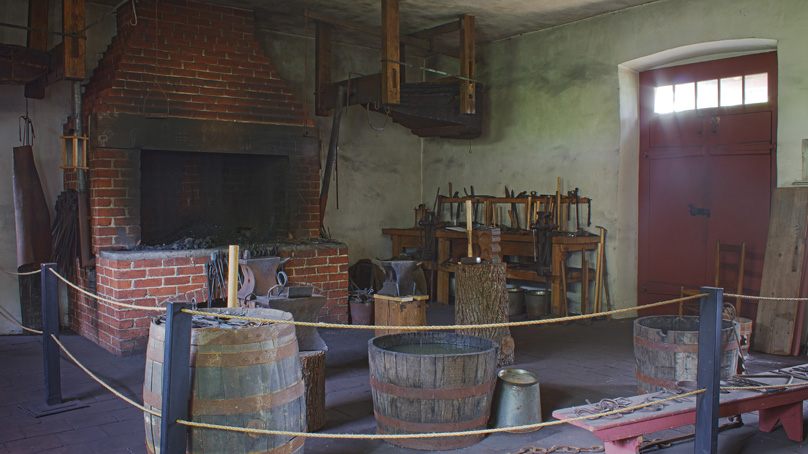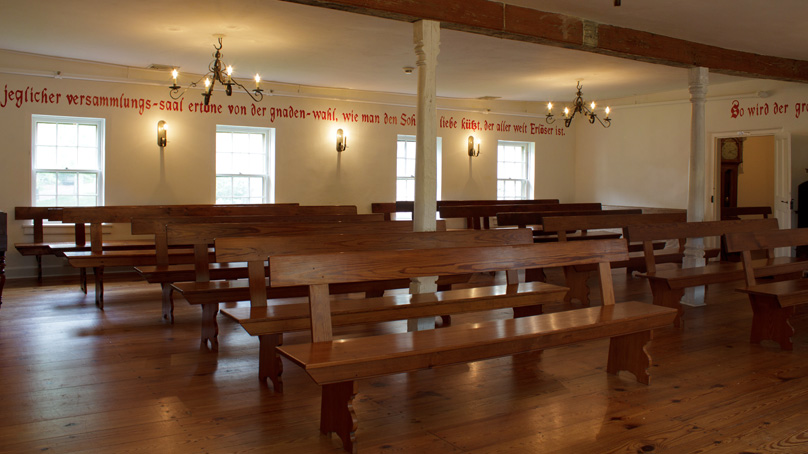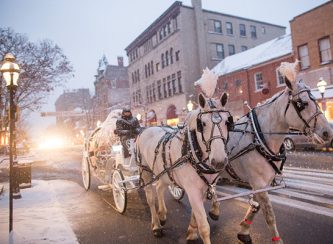Bethlehem Colonial History
Welcome to Bethlehem, Pennsylvania, also known as Christmas City, USA.
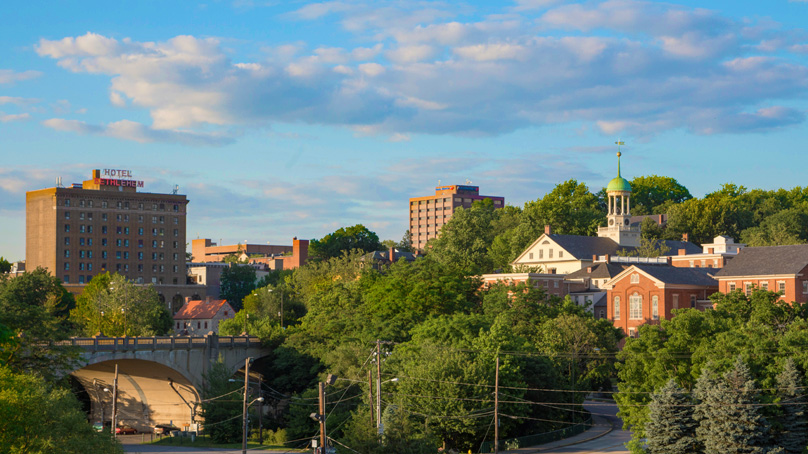
Bethlehem was founded over 250 years ago in 1741 when a religious group, members of the Moravian Church, purchased land where the Monocacy Creek flows into the Lehigh River. Bethlehem was christened on Christmas Eve, 1741, in a stable while the small group of Moravians were singing a hymn with the stanza “Not Jerusalem, Lowly Bethlehem.” Bethlehem is truly Christmas City, USA.
Our city has a fascinating history. In 1741, the first Moravians felled white oak trees and began building their community on the 500 acre tract purchased in the spring. They located their crafts, trades, and industries along the Monocacy Creek and Lehigh River and their institutional dwellings on the limestone bluff along what is now Church Street.
The earliest structures were built of hewn logs. The first house no longer exists; however, the second structure, known as the 1741 Gemeinhaus (National Historic Landmark), is still standing and houses the Moravian Museum of Bethlehem. A majority of the 18th century colonial Germanic stone structures remain including the 1744-1772 Bell House / Sisters’ House Complex, 1748 Single Brethren’s House, 1751 Old Chapel, 1758 Sun Inn, 1761 Tannery, 1762 Waterworks (National Historic Landmark), 1768 Widows’ House, 1782-1830 Miller’s House, and the archeological remains of the butchery, dye house, pottery, and oil mill. These buildings are considered the finest examples of 18th century colonial Germanic architecture in America.

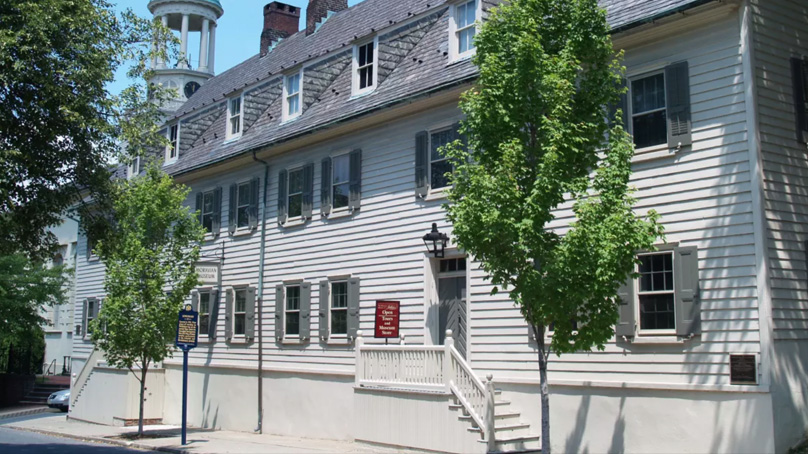

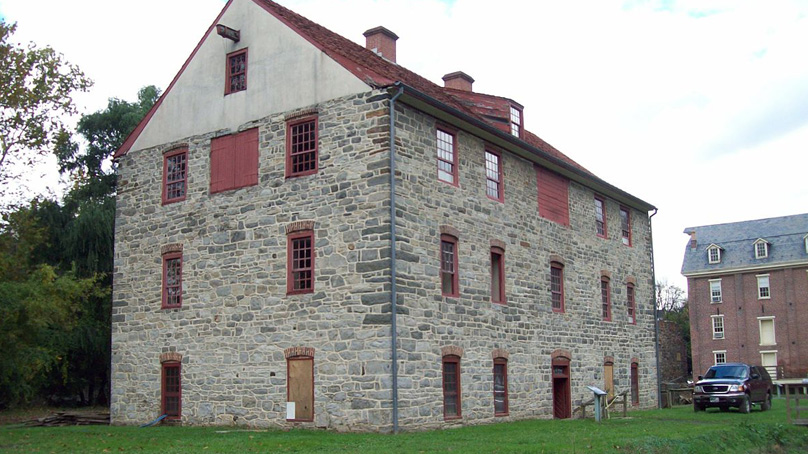
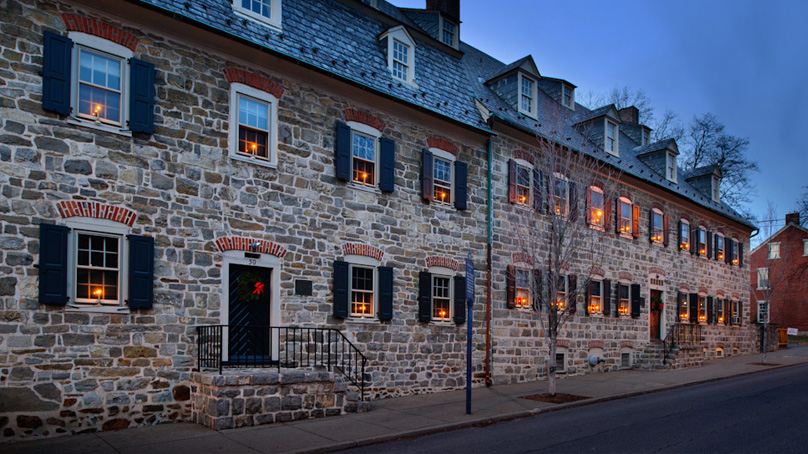
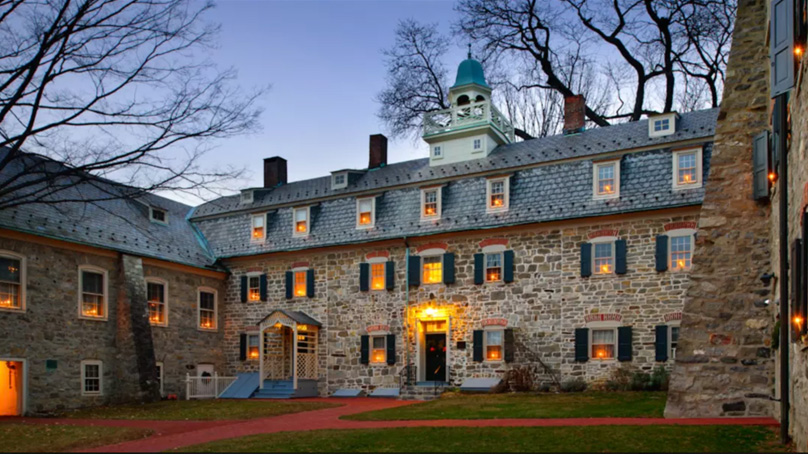
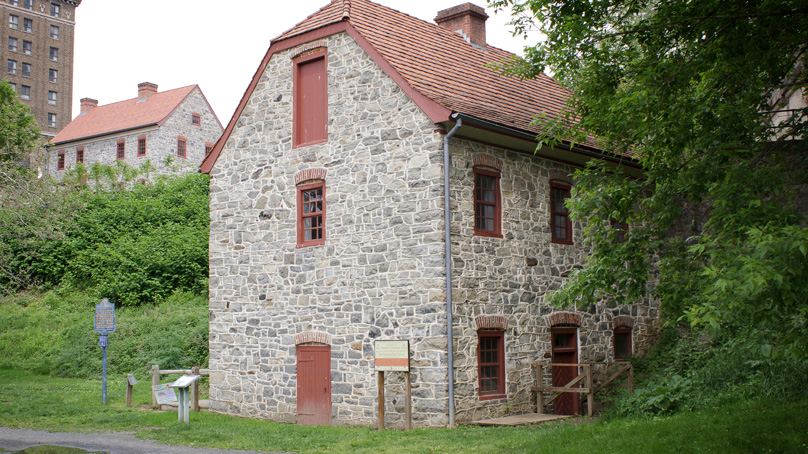
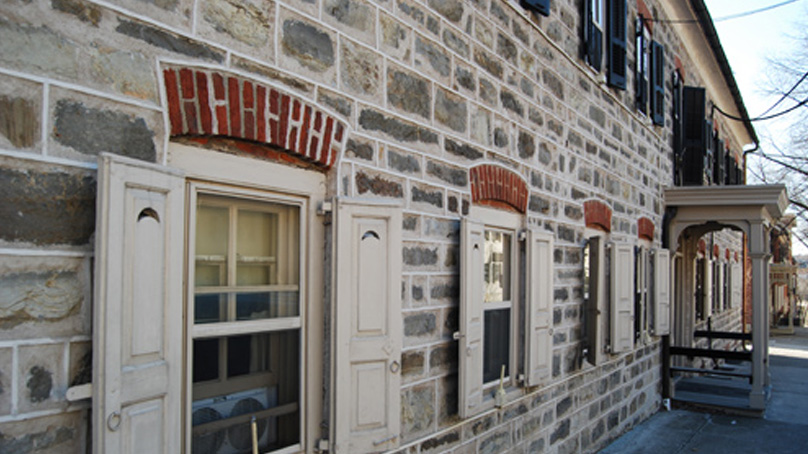
Bethlehem is fortunate to have two National Historic Landmarks. The 1741 Gemeinhaus, the largest 18th century log structure in continuous use in the United States, was the birthplace of Lewis David von Schweinitz, the Father of American Mycology. The 1762 Waterworks is America’s first pumped municipal water system. Bethlehem was a diverse community with Moravians coming from all over Europe. Although German was their common language, 15 different languages were spoken here. Education for both boys and girls was very important and in 1742, they first established a school for girls and several months later a school for boys. The schools have become Moravian Academy, an independent school from pre-K through grade 12, and Moravian College and Theological Seminary. Later in the 1860s, Lehigh University was founded originally to train future leaders of industry.
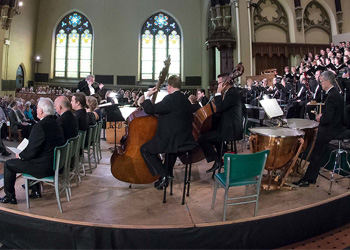
Bach Choir of Bethlehem
Music was also very important to the community. One of the earliest orchestras in America was founded here in 1744. Today, the Bach Choir of Bethlehem and the Moravian Trombone Choir, the oldest musical group in America founded in 1754, continue that tradition.
During the Revolutionary War, the Moravians were pacifists but doubled their output of hides to support the American cause. The Continental Army Hospital was located here in the Brethren’s House. Over 500 soldiers died in Bethlehem and are buried on the hillside along First Avenue. The story of Moravian farming still exists in the historic site known as the 1748-1848 Burnside Plantation which interprets early farming within the city limits of our community.
With the coming of the canal in the late 1820s, the community was changing. In the early years, Bethlehem was a closed community with the Moravian Church owning all the land. In 1845, the Church began selling off its property and Bethlehem was incorporated as a borough.The development of the railroads in the mid 1800s spurred further development of industry starting with zinc, then iron and steel, cigar factories and silk mills. The Moravian farms on the southside of the river became transformed into building lots and the place for the growth of industry. Beginning in the 1850s, many waves of immigrants from all over Europe and later the Americas settled on the southside to work in the factories and mills. Once again many languages and ethnic traditions were found here. South Bethlehem was incorporated as a separate borough in 1865.
Bethlehem was christened on Christmas Eve, 1741, in a stable while the small group of Moravians were singing a hymn with the stanza “Not Jerusalem, Lowly Bethlehem” so Bethlehem is truly Christmas City, USA
The west side of the Monocacy also grew rapidly in the late 1800s after the Broad Street Bridge was completed and then West Bethlehem was incorporated as a separate borough in 1886. It was not until 1917 that the three Bethlehems were united into one town.
Bethlehem today has six National Register Historic Districts, many historic sites and museums, a very active arts and culture scene and is one of the 100 Best Places to live in the US according Money Magazine.
Colonial Industrial History
Along the Monocacy Creek and the Lehigh River, the Moravian community immediately began building their heavy industrial area initially using small log structures for their workshops. Within two years of their arrival in Bethlehem, the Moravians built a saw mill, soap mill, and wash houses; constructed their first grist mill, oil mill, tannery, blacksmith shop and brass foundry. By 1747, thirty-five (35) crafts, trades and industries were established including a butchery, tawery, clockmaker, tinsmith, nailor, pewterer, hatter, spinning, weaving, cooper, dye house, community bakery, candlemaker, linen bleachery, fulling mill, saddlery, tailor, cobbler, flax processing, wheelwright, carpenter, mason.

1869 Luckenbach Mill
As the community developed, they replaced the log buildings with larger limestone buildings. The pottery, tannery, butchery, dye house, smith complex, oil mill, and waterworks were built of stone in the period from the late 1740s through the early 1770s. Bethlehem’s Colonial Industrial Quarter had the largest concentration of pre-industrial revolution crafts, trades and industries in America and can be considered America’s earliest industrial park. Some of the early industrial buildings remain.
The goal of the Moravians in Bethlehem was to be a self-sufficient community on the colonial frontier in order to provide for themselves and for their missionaries in the field.
With the Industrial Revolution, cheaper mass-produced goods became available and there was a decline in the market for hand-made goods. By the 1850s, other industries were coming to Bethlehem including the forerunner of Bethlehem Steel Corporation which rose to become the second largest steel producer in the United States.
Today even with the loss of the Steel, Bethlehem has a very diverse industrial base of technology and industrial parks with two located within the city.

Industrial History
Bethlehem Steel
Bethlehem Steel Corporation was incorporated in December 1904, when it was acquired by Charles Schwab, who built it into the second largest steel company in the country. Its early history can be traced to 1857, when the Saucona Iron Company was established, later to become the Bethlehem Iron Company. John Fritz, one of America’s great ironmasters, came to Bethlehem in 1860 from the Cambria Iron Company in Johnstown, Pennsylvania, to develop the iron works and served as general superintendent of the Bethlehem Plant until his retirement some thirty years later.
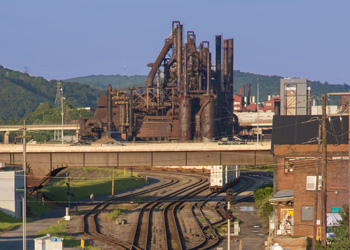
Bethlehem Steelstacks Today
Bethlehem established itself as a significant supplier of forged products, steel rail and ordnance before Mr. Schwab acquired the rights to the Grey Mill and produced the nation’s first rolled wide-flange structural steel beams in 1908. Bethlehem Steel also made its name as the world’s largest shipbuilder through two World Wars, building an impressive 1,127 ships during World War II. Bethlehem’s facilities stretched from coast-to-coast, with numerous steelmaking and manufacturing plants, coal mines, quarries, ore mines, and shipbuilding and ship repair yards supplying the nation’s needs. Bethlehem’s peak employment corporate-wide reached about 300,000 while the Bethlehem Plant employed almost 33,000 to supply the war effort. After almost one hundred years in existence, Bethlehem Steel Corporation filed for bankruptcy in 2001.
The local Bethlehem Plant occupied 1,800 acres that stretched four-and-a-half miles along the Lehigh River and beyond. Its history is significant for its many “firsts,” including the perfection of high-speed tool steel that paved the way for modern industrial expansion and for its extraordinary contribution to the defense of our nation. Its mainstay products were the structural products, ordnance and heavy forgings. The legacy of the Bethlehem Plant is being preserved as part of a planned brownfield redevelopment incorporating significant historic manufacturing facilities and iconic structures.
